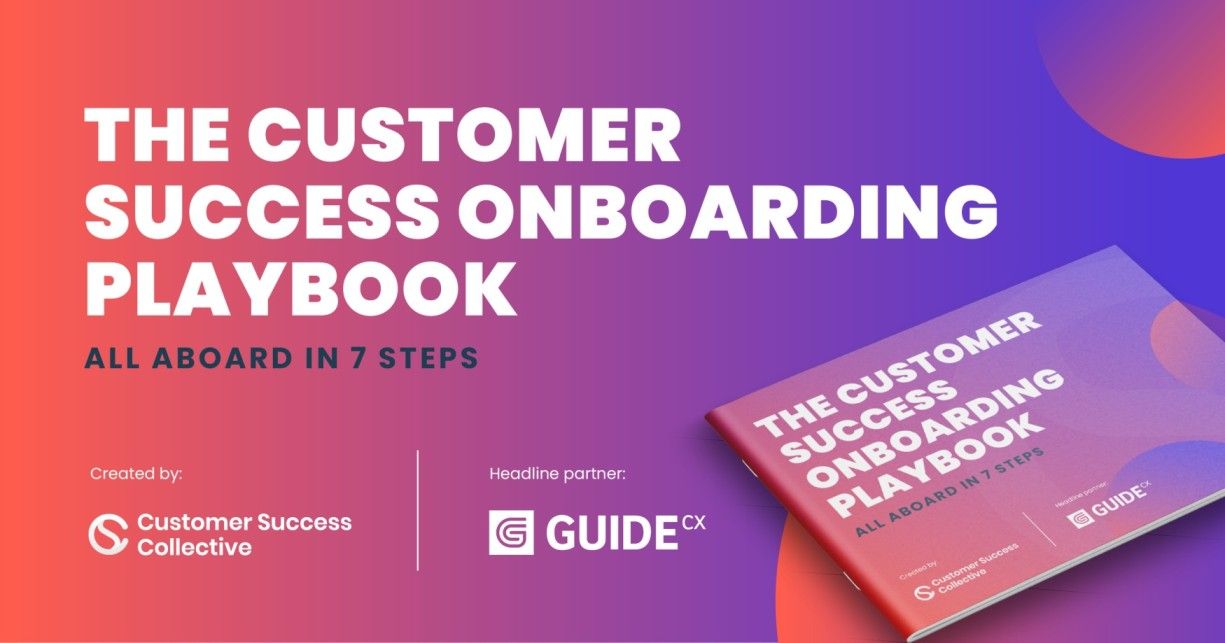This article is based on a presentation given by David at the Customer Success Festival in Austin, in February 2023.
Catch up on this presentation, and others, using our OnDemand service. For more exclusive content, visit your membership dashboard.
The world of customer success has undergone significant transformations in recent years, driven by the rise of digital-first approaches and the ever-changing economic landscape.
As organizations navigate the challenges and opportunities presented by this new paradigm, it becomes crucial to adapt and refine existing strategies to ensure customer satisfaction, retention, and long-term success.
My name is David Gunn, VP of Customer Success at LinearB, and I'm excited to delve into the topic of enabling efficiency and creating value through digital-first customer success. This has been particularly significant to me this year as we've had to adapt to the changing economic climate. It's been truly fascinating to witness the impact of these adjustments.
Let's embark on this journey together, exploring the power of digital-first customer success and discovering how it can revolutionize your organization's approach to customer engagement, retention, and growth.
The need for a digital-first approach: Adapting to growth and economic challenges
Let me tell you about the current state of affairs at LinearB. As a relatively new startup, when I joined we had fewer than 200 customers, and our customer success organization was still in its infancy.
I only had two Customer Success Managers (CSMs) on my team. Their primary focus was providing highly technical, white-glove onboarding experiences to ensure a positive initial impression for our customers. Our product was complex, and we aimed to guide each customer through its intricacies. Additionally, deal sizes were relatively small, as is often the case in the startup world.
However, everything changed when we received a significant Series B investment. Suddenly, we were tasked with rapid growth and set a target of expanding by 3.5 times within a year.
To achieve this, we ventured into the enterprise space, which necessitated a significant transformation for our CSMs. They were now required to handle larger deals, more complex customers, and engage in high-touch interactions on a regular basis.
Despite these new demands, we still had to dedicate considerable time to comprehensive enterprise onboarding, which became a bottleneck. The time spent onboarding enterprise clients meant that our smaller customers were not receiving the attention they deserved.
Alternatively, if we did prioritize the smaller clients, it would come at the expense of the larger accounts. This situation created confusion and inefficiency. To make matters more challenging, shortly after securing the funding, a global economic slowdown ensued, further complicating matters for us.
Reframing the approach: Overcoming skepticism and implementing a data-driven strategy
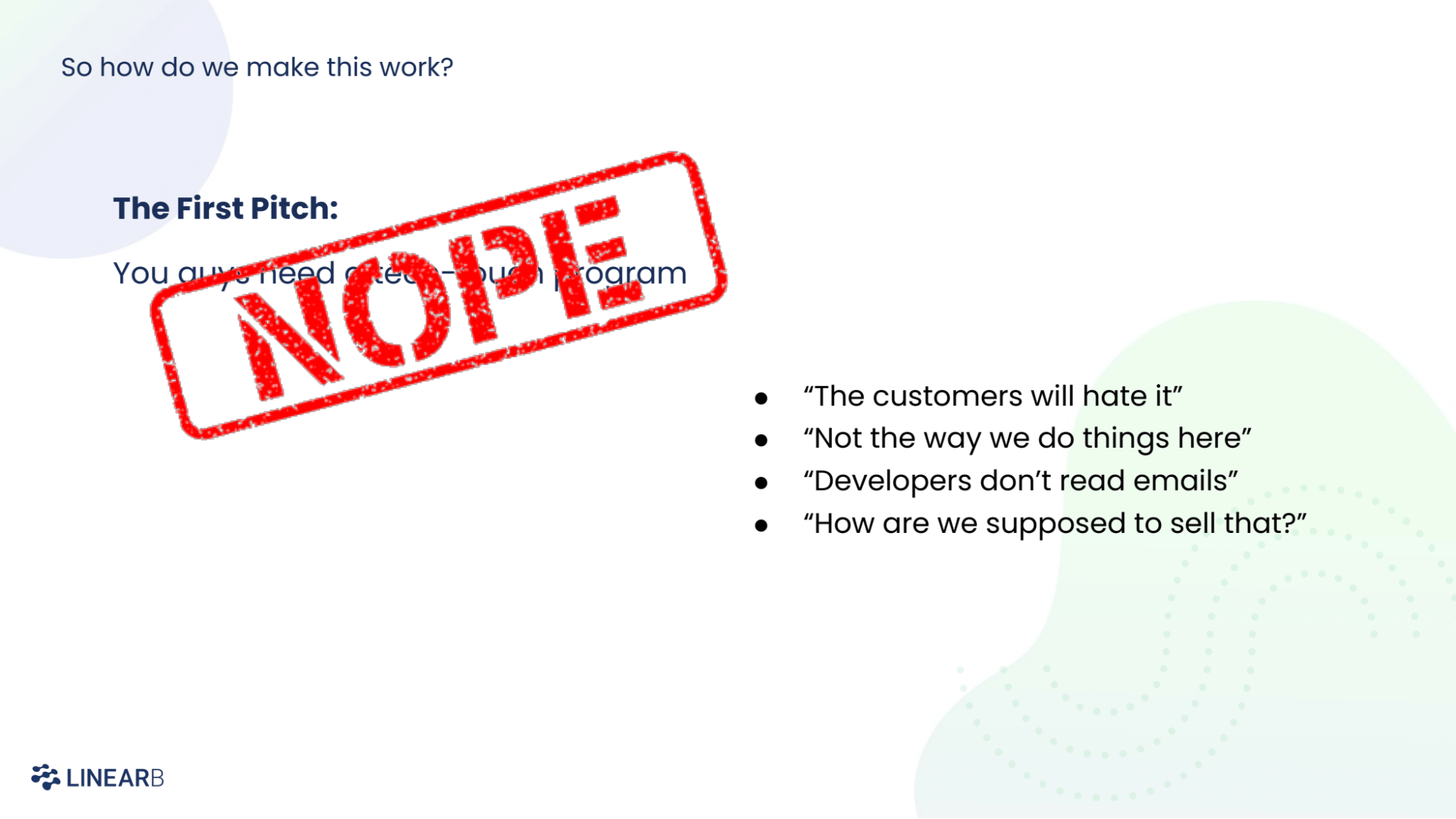
We needed to make our funding last longer than anticipated due to the uncertain economic climate. Drawing from my previous experiences in CS, I believed there was a solution: implementing a tech-touch program. The idea was to automate processes, cater to the smaller customers more efficiently, and free up our CSMs' time.
During a leadership meeting where I presented my proposal, I faced skepticism. Some direct quotes from the meeting included: "Customers are gonna hate it," "This is not the way we do things here," and the repeated notion that "developers don't read emails."
Our sales team and account executives voiced concerns about selling such a program. They rightly pointed out that it contradicted our emphasis on white glove customer success. The term "tech touch" had a negative connotation, and no one wanted to be associated with it.
Realizing the need to reframe our approach, we decided to take a more data-driven stance. We delved into the numbers, examining both customer spending and the amount of time our CSMs dedicated to different accounts.
This analysis revealed a notable trend: our CSMs were spending over 60% of their time assisting smaller customers. These accounts, although numerous, contributed to less than 30% of our annual recurring revenue (ARR), or even less.
The CSMs were heavily engaged in onboarding, technical support, and product training. Additionally, the lack of a dedicated support director meant they had to handle various tasks. Consequently, only around 10% of their time was spent on strategic and consultative activities. The majority of their efforts were focused on troubleshooting and quick responses.
With these insights in hand, I presented a new question to the board:
What if we automated repetitive tasks and focused on streamlining the initial outreach?
This marked the first step toward gaining their buy-in.
However, we were cautious in our branding approach. We emphasized that it was a digital-first approach to customer engagement rather than a digital-only strategy. This meant implementing automated messaging, developing consistent playbooks, and maintaining vigilant monitoring throughout the entire process.
We assured the leadership team that we still had CSMs available if any situation required their expertise. This provided a safety net and eased concerns about a fully digital program.
Phase one: Standardizing onboarding and enhancing customer communication efficiency
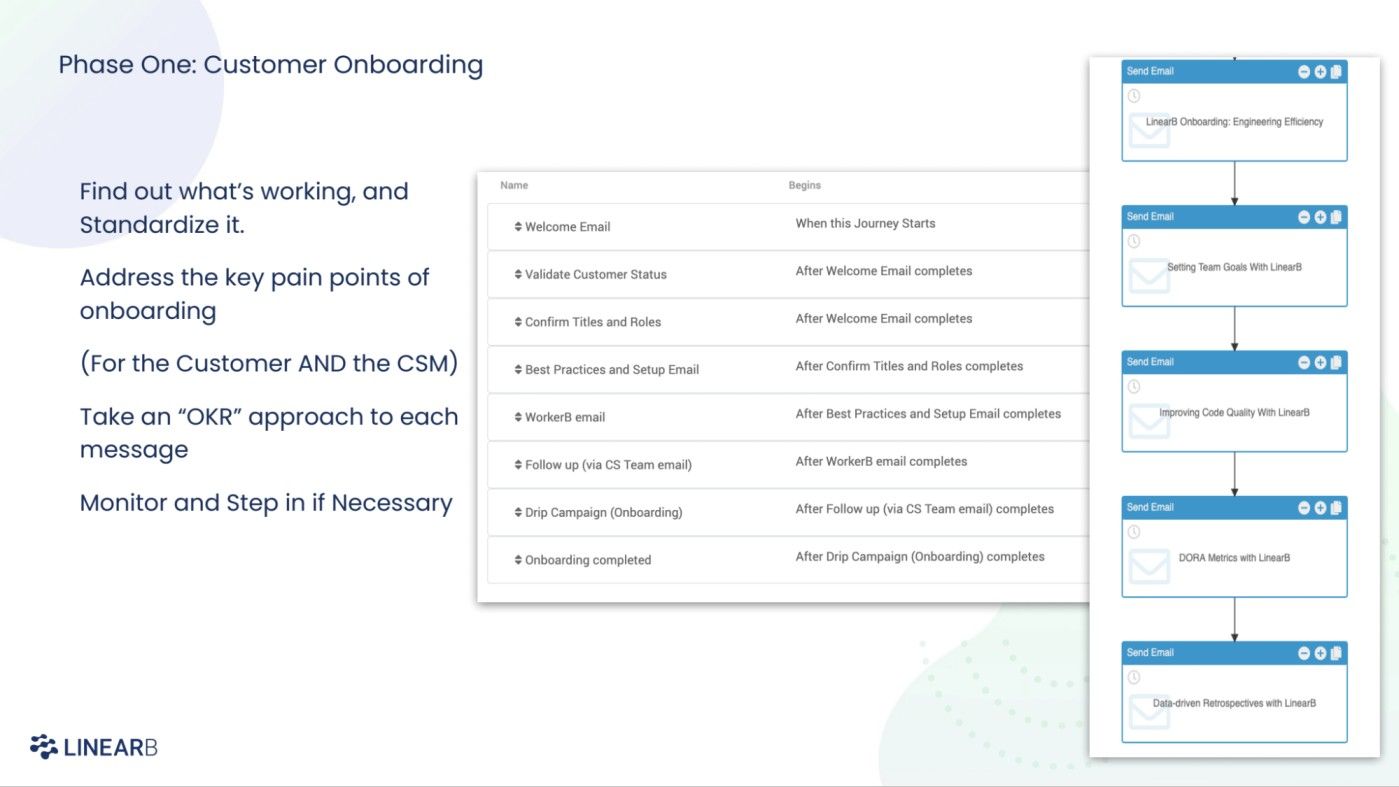
In phase one of our transformation, we focused on onboarding – the initial stage of the customer journey. We discovered that despite having only two CSMs – one in the US and the other in EMEA — they were following their own unique approaches.
Each CSM had their own email templates, engagement strategies, cadence, and pitch. While individual creativity was valuable, we recognized the need for collaboration and standardization. We decided to share best practices and evaluate what was working effectively.
For example, our CSM in Tel Aviv excelled at training content, so we sought to leverage their expertise across all our customers. Similarly, our CSM in the States had a knack for onboarding and pitching. We wanted to capture their success and incorporate it into our automated processes.
To identify key pain points, we approached the analysis from two angles. First, we examined the customer experience to pinpoint areas where improvements were needed. Second, we assessed the challenges faced by our CSMs — what obstacles hindered their ability to perform their roles effectively.
Once we identified these pain points, we devised a plan to address them incrementally. However, we also recognized the importance of a feedback loop. We didn't want our approach to be strictly digital. Instead, we implemented a feedback mechanism to gather insights on what was working and what needed improvement.

To achieve this, we adopted a mini Objectives and Key Results (OKR) framework for each message we developed. By defining clear objectives and determining key results that indicated progress, we could track our success in moving the needle.
For instance, if our objective was to help customers set team goals within the platform, successful key results might include creating specific dashboards, generating specific reports, and completing relevant training. By aligning our messages with these objectives and key results, we ensured that each step of the customer journey had a defined outcome in mind.
Monitoring and intervention were vital components of our strategy. We needed to be able to oversee the process at scale and step in when necessary. It was a matter of doing more with less — maximizing efficiency and impact despite limited resources.
Leveraging tools and streamlining customer communication
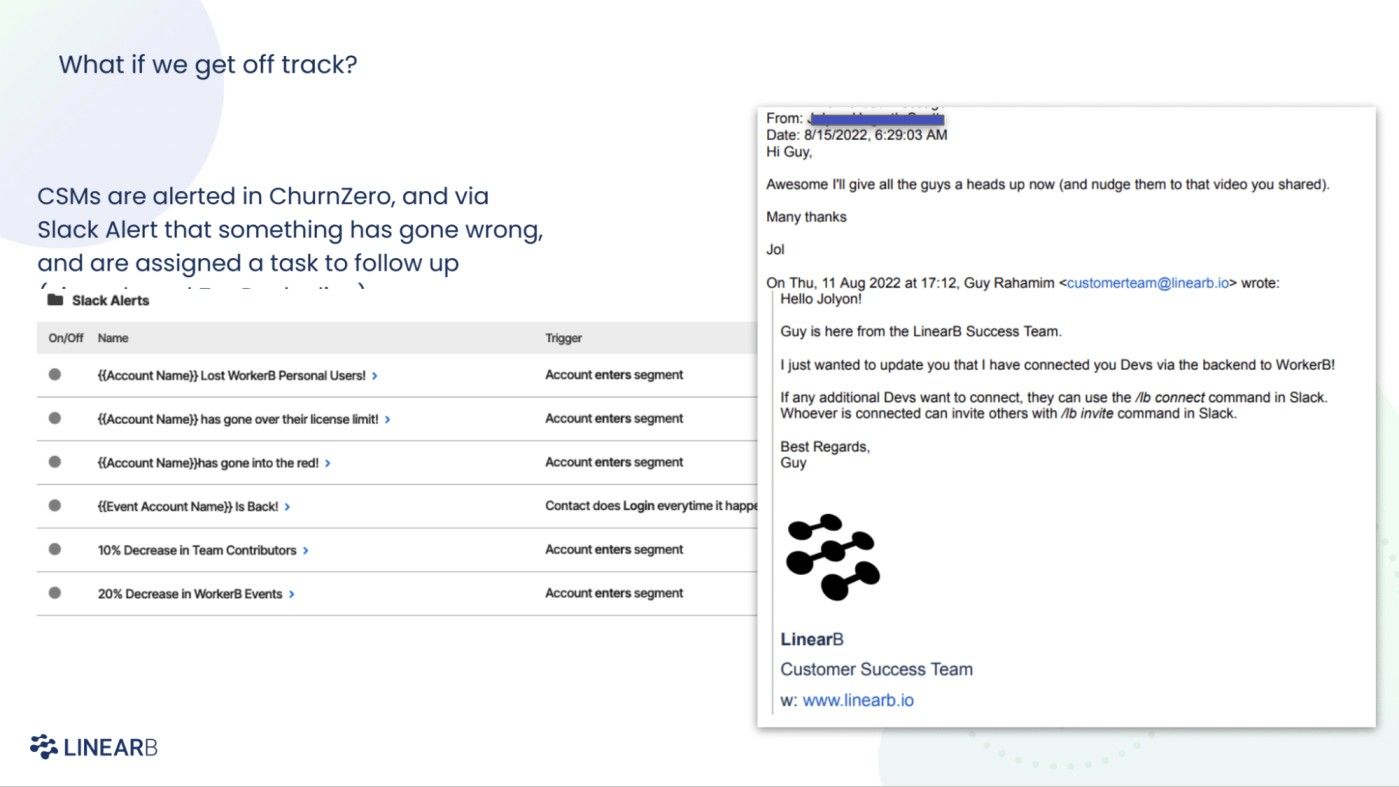
We had access to a tool called ChurnZero, which played a crucial role in our transformation. We leveraged ChurnZero to set up alerts for our CSMs. Recognizing that our CSMs were more active on Slack than in the ChurnZero dashboard, we devised a solution.
We automated the process of pushing alerts from ChurnZero to Slack, ensuring that our CSMs could receive real-time notifications and stay informed.
These alerts covered various situations, such as customers losing personal users, exceeding license limits, or experiencing a decline in their health score. With this information at their fingertips, our CSMs could respond promptly and proactively address any emerging issues.
To streamline customer communication and reduce dependency on individual CSMs, we established a generic email address through Zendesk, which we already used for technical support. This email alias was accessible to all our CSMs.
The intention behind this initiative was to train customers to rely less on direct CSM contact for every query or concern. Instead, we aimed to promote the idea of a shared resource, where customers could reach out to the pooled expertise of our customer team. So although the emails were crafted by individual CSMs, they were sent from a generic address to reinforce the idea of a collective support network.
For example, if we received an alert indicating a customer's webhook connection issue, the assigned CSM would promptly respond using the customer team email alias. The CSM would inform the customer about the problem and explain that it had been resolved. Additionally, they might provide a video tutorial for future reference.
This approach allowed us to address the customer's needs efficiently without the need for scheduling a call or engaging in time-consuming back-and-forth communication. The customer's response to this automated action demonstrated the effectiveness of this streamlined approach, as they expressed gratitude and indicated their intention to watch the provided video.
By implementing these automated actions and utilizing tools like ChurnZero, we optimized our time management, reduced unnecessary interactions, and provided prompt support to our customers.
Positive results and enhanced customer experience in phase one
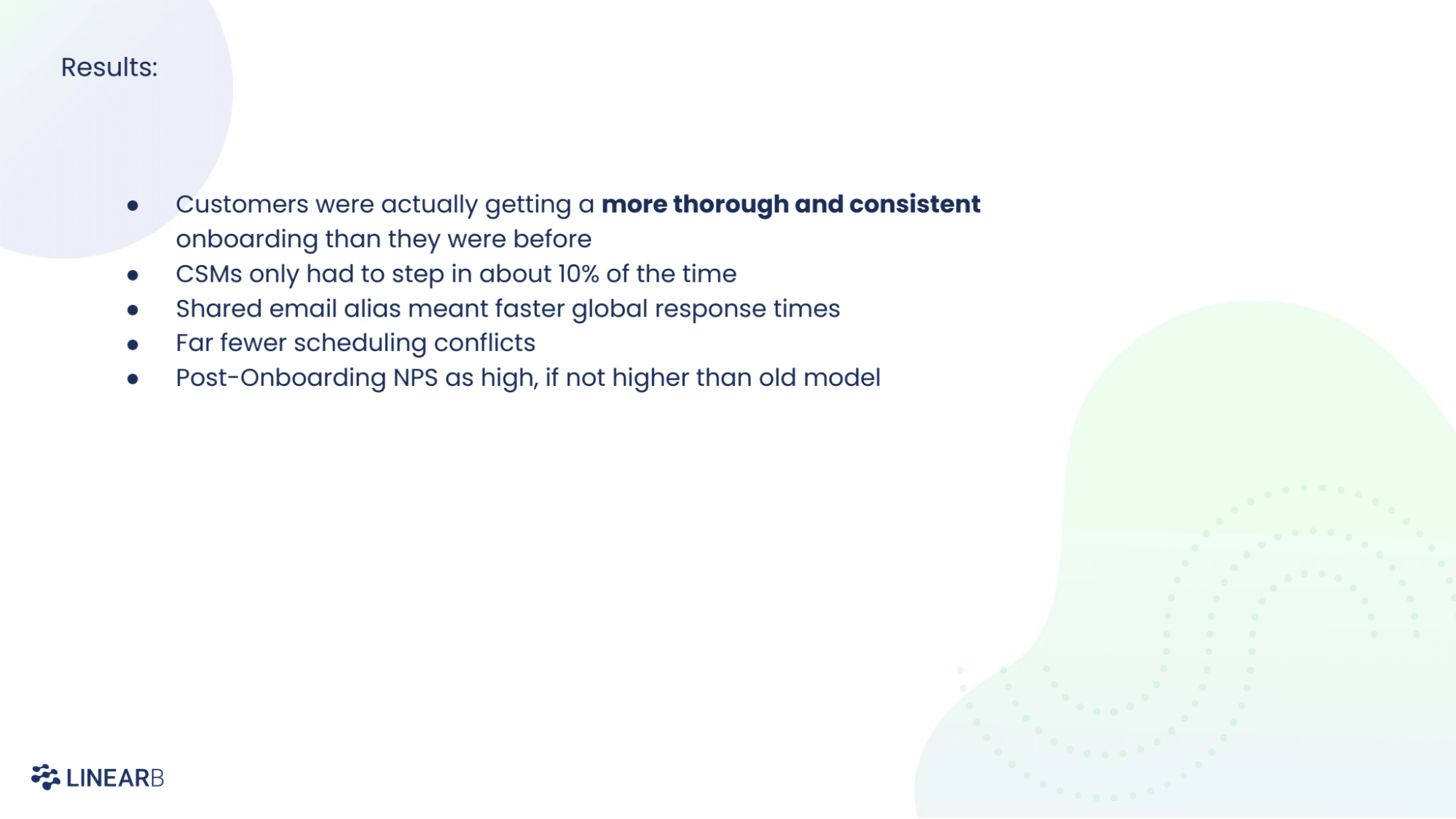
The results of our phase one efforts were highly encouraging. Customers experienced a more thorough and consistent onboarding process than before. No longer was it a free-for-all where each CSM had their own approach.
We consolidated and standardized the onboarding process, making it uniform for all customers. We welcomed feedback and made necessary adjustments to improve the experience continuously. This approach ensured that everyone was on the same page and benefited from a streamlined onboarding journey.
Initially, we had concerns that CSMs might have to intervene frequently, potentially negating time savings. However, to our surprise, customers embraced the self-guided approach we provided.
Working with developers, we recognized their inclination to figure things out independently without spending unnecessary time on phone calls. We equipped them with the necessary tools and documentation, empowering them to resolve most inquiries on their own.
Only about 10% of the time did CSMs need to step in to address quick questions, which they efficiently handled by providing relevant documentation and assistance. This minimized disruptions and allowed the process to proceed smoothly.
An unexpected benefit emerged from the implementation of the shared email alias. Response times significantly improved. With CSMs based in different regions and a global customer base, time zone differences often resulted in delays.
Previously, a customer from India might have to wait an entire day for a response if their CSM in Tel Aviv was unavailable. However, the shared email approach enabled all CSMs to monitor and assist one another.
If a customer's designated CSM was unavailable, another CSM would step in and promptly address the query. This collaborative approach drastically reduced response times, mitigated scheduling conflicts, and enhanced overall customer satisfaction.
To further optimize scheduling, we implemented a tool called Chili Piper. By incorporating shared calendars into our email blasts, customers could book meetings based on the availability of any CSM.
The system automatically matched customers with an available CSM during their preferred time slot, eliminating concerns about double booking. This streamlined the process and ensured efficient use of everyone's time.
Throughout this phase, we closely monitored customer feedback, particularly through post-onboarding Net Promoter Score (NPS) surveys. We were pleased to discover that our NPS scores remained as high, if not higher, than under our previous model. Remarkably, we achieved these positive outcomes with 90% less direct engagement. Customer satisfaction remained strong, reinforcing the effectiveness of our digital-first approach.
Overall, our phase one initiative led to a more comprehensive onboarding experience, faster response times, improved scheduling efficiency, and sustained customer happiness despite significantly reduced engagement.

Streamlining onboarding and enhancing customer satisfaction
We recognized the importance of keeping customers engaged throughout the middle section of their journey. We acknowledged that many programs tend to provide intensive engagement during the initial onboarding phase, only to taper off afterward, leaving customers to navigate on their own until the renewal period.
We aimed to avoid this common pitfall by ensuring ongoing engagement through the delivery of quality and relevant content that would grow in complexity alongside the customers' evolving needs.
Our approach involved crafting a series of emails that gradually introduced customers to more strategic topics and advanced functionalities. We started with quick how-to guides but then progressed to addressing workflow bottlenecks, establishing attainable goals for teams, and devising organization-level workflow optimization strategies.
Initially, our emails were dense with information, resembling data dumps. Although our open rates were impressive, the click-through rates were lackluster. Customers would open the emails, become overwhelmed by the volume of text, and quickly move on.
To address this issue, we adjusted our strategy. We began incorporating teaser content into the emails to pique interest. Each email now consisted of a concise overview and links to learn more or schedule a call. By offering these options, we catered to different customer profiles.
Some customers preferred to tackle tasks independently and would appreciate the opportunity to explore the documentation at their own pace. Others found the complexity overwhelming and welcomed the option to schedule a call for guided assistance.
These adjusted emails proved effective in engaging customers. We observed remarkable open rates, averaging around 40%. This demonstrated that customers recognized the value of the content we provided.
These were not generic marketing blasts, but instead, practical resources aimed at improving their processes and maximizing their use of our tool. Customers could decide whether they needed assistance or felt confident proceeding on their own.
By maintaining ongoing engagement through relevant content and offering different pathways for assistance, we ensured that customers remained connected and empowered throughout their journey.
The high open rates indicated that our approach resonated with customers, offering valuable insights and support tailored to their evolving needs. Whether customers felt self-sufficient or required further guidance, our strategy allowed them to make informed decisions about how to proceed.
Phase two: Automation, risk mitigation, and targeted communications
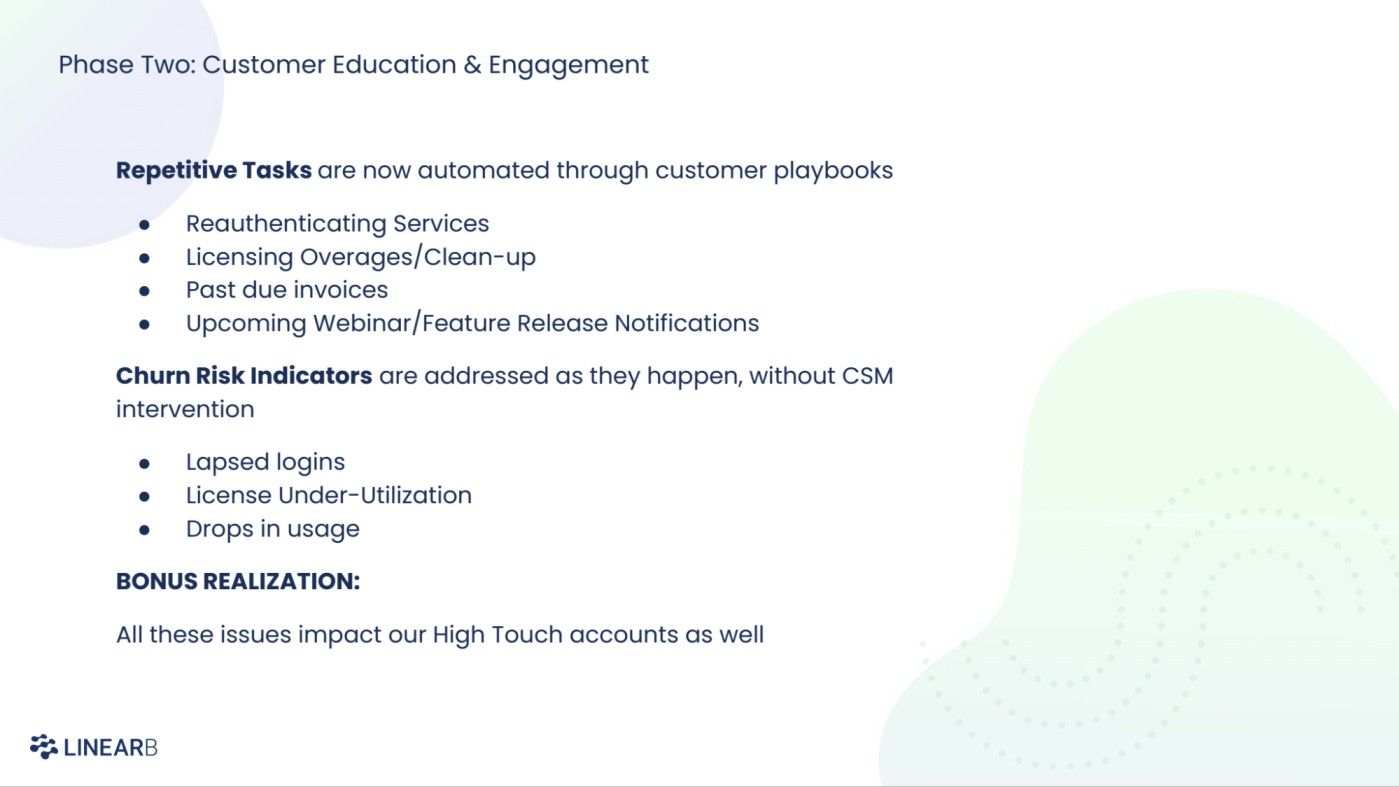
As we delved into phase two of our transformation, we noticed that many repetitive tasks were now being automated through our playbooks. These tasks, which previously consumed a significant portion of the CSMs' time, included re-authenticating services like Git and JIRA when tokens expired.
Instead of the CSMs reaching out and guiding customers through the process, an automated email was triggered, providing clear instructions on how to re-authenticate. This shift not only saved the CSMs' time but also ensured that customers could swiftly regain their configured settings.
We also automated processes related to license overages. As we employed a licensing model based on the number of users, we would send quick messages notifying customers if they were approaching or exceeding their license limit.
We offered options for resolution, such as cleaning up inactive users, and provided assistance through scheduled meetings if needed. By proactively addressing potential issues, we facilitated smoother operations for our customers.
Another area where automation proved effective was in handling past-due invoices. Instead of pursuing overdue payments, we took a proactive approach by sending reminders to customers' accounting email addresses.
This approach prompted customers to address the issue promptly, as they realized the importance of maintaining access to our tool. We successfully shifted the responsibility of invoice resolution from our team to the customers themselves.
Occasionally, we would send out emails to inform customers about upcoming webinars or feature releases. However, it was crucial for us to maintain the primary focus of these communications on providing information rather than turning them into marketing blasts. To ensure relevance, we implemented thorough targeting strategies.
For example, if a feature release only applied to JIRA users, we made sure that only those users received the announcement. This targeted approach prevented unnecessary confusion and ensured that customers received tailored information.
Addressing churn risk became a key concern for us. We identified several leading indicators of potential churn, such as a decrease in login activity, underutilization of licenses (e.g., purchasing 20 licenses but activating only eight), and drops in usage. However, with CSMs managing a substantial number of accounts, particularly with high-value enterprise accounts, it was challenging for them to keep track of all the smaller accounts.
To overcome this limitation, we implemented early alert systems that provided quick notifications for potential churn indicators. This approach allowed CSMs to promptly address issues and mitigate risks.
Furthermore, as we extended our digital-first tools and practices to enterprise customers, we saved even more time for CSMs at that level. Automated processes and alerts meant that CSMs could focus their time and expertise on strategic engagement and consultative approaches during customer interactions.
By automating repetitive tasks, addressing potential risks, and leveraging targeted communications, we achieved greater efficiency, improved customer satisfaction, and enabled CSMs to engage in more meaningful interactions with customers across different segments.
Navigating economic impacts and forecasting retention: Addressing churn challenges
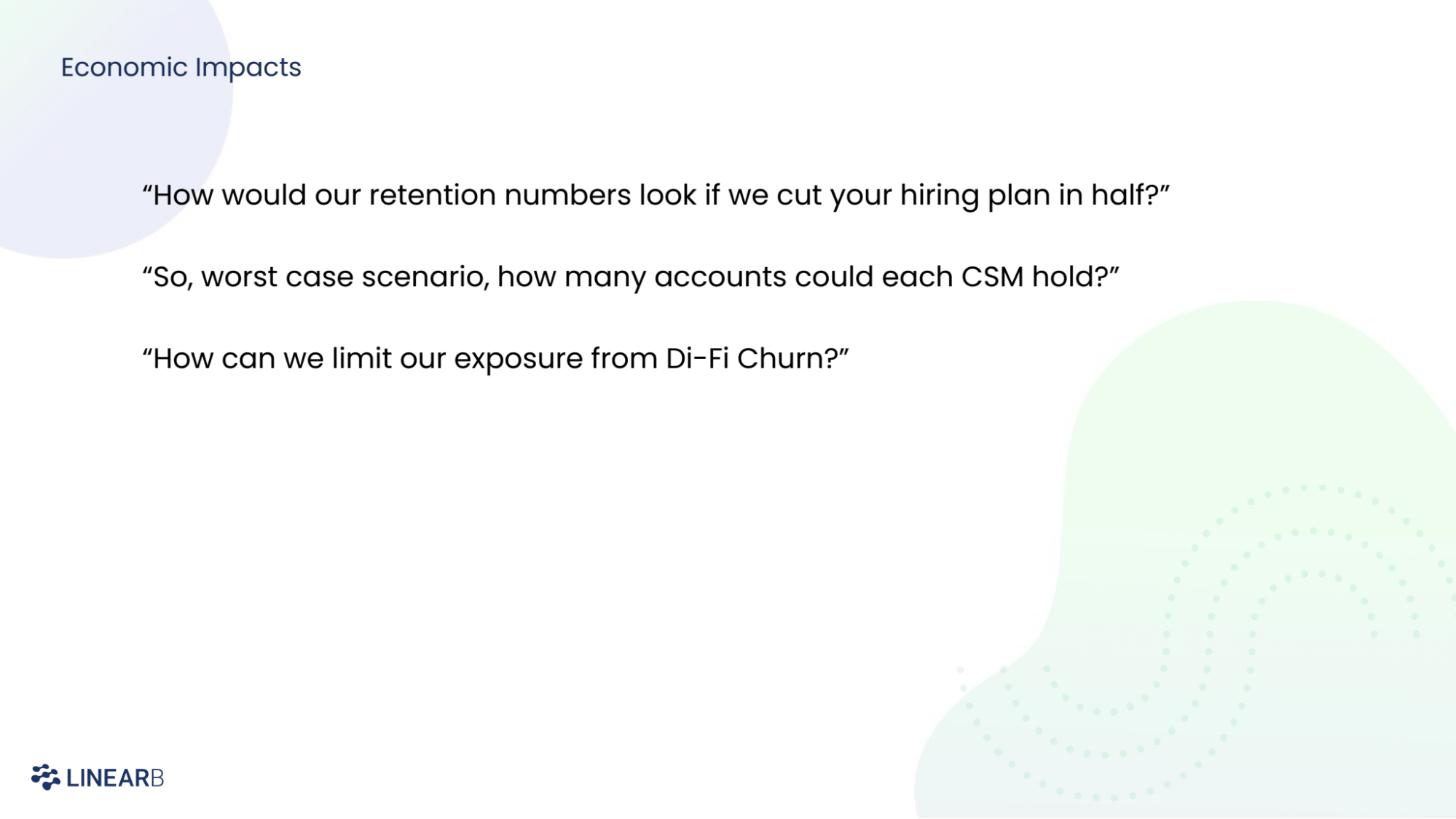
Let's dive into the economic impacts we've all experienced, which have undoubtedly made customer success a challenging endeavor. We've been faced with difficult questions like how our retention numbers would look if our hiring plan was cut in half or if we had to manage with fewer resources. We've also grappled with the pressing issue of limiting digital-first churn and finding ways to forecast retention more effectively.
One crucial realization is that churn is a lagging indicator. If we rely solely on churn to assess the success of our initiatives, it's often too late to make meaningful adjustments. Therefore, we've placed greater emphasis on early forecasting.
We've sought to identify the primary drivers of churn and recognize warning signs sooner. The goal is to determine what we have control over and what falls outside our influence. While some factors, such as budget cuts or organizational changes, may be beyond our control, we can still strive to minimize surprises and proactively address preventable churn.
To approach this challenge, we've developed a matrix to analyze churn. We consider two key aspects:
- The percentage of churn that was forecasted, and
- The distinction between preventable and unpreventable churn.
By focusing on preventing surprises and reducing unforecasted churn, we can provide our board with advanced notice of potential issues. This proactive approach demonstrates our commitment and ability to navigate challenges effectively.
Gaining customer insights is vital in this process, and leveraging tools like LinkedIn Sales Navigator can be invaluable. Monitoring customers' activities and changes within their organizations allows us to stay ahead of potential churn triggers.
If budget constraints prevent access to such tools, Google News Alerts can be a useful alternative. Setting up alerts for keywords related to our customers, such as layoffs or acquisitions, ensures we are promptly informed and can take necessary actions.
Within the preventable churn category, we shift our focus to factors within our control as CSMs. This includes tackling issues such as lack of adoption, perceived value, and engagement. It's a reflection of our responsibility to effectively communicate the value of our product and engage with the right stakeholders at the right time.
Addressing these preventable churn factors becomes a priority for us moving forward.
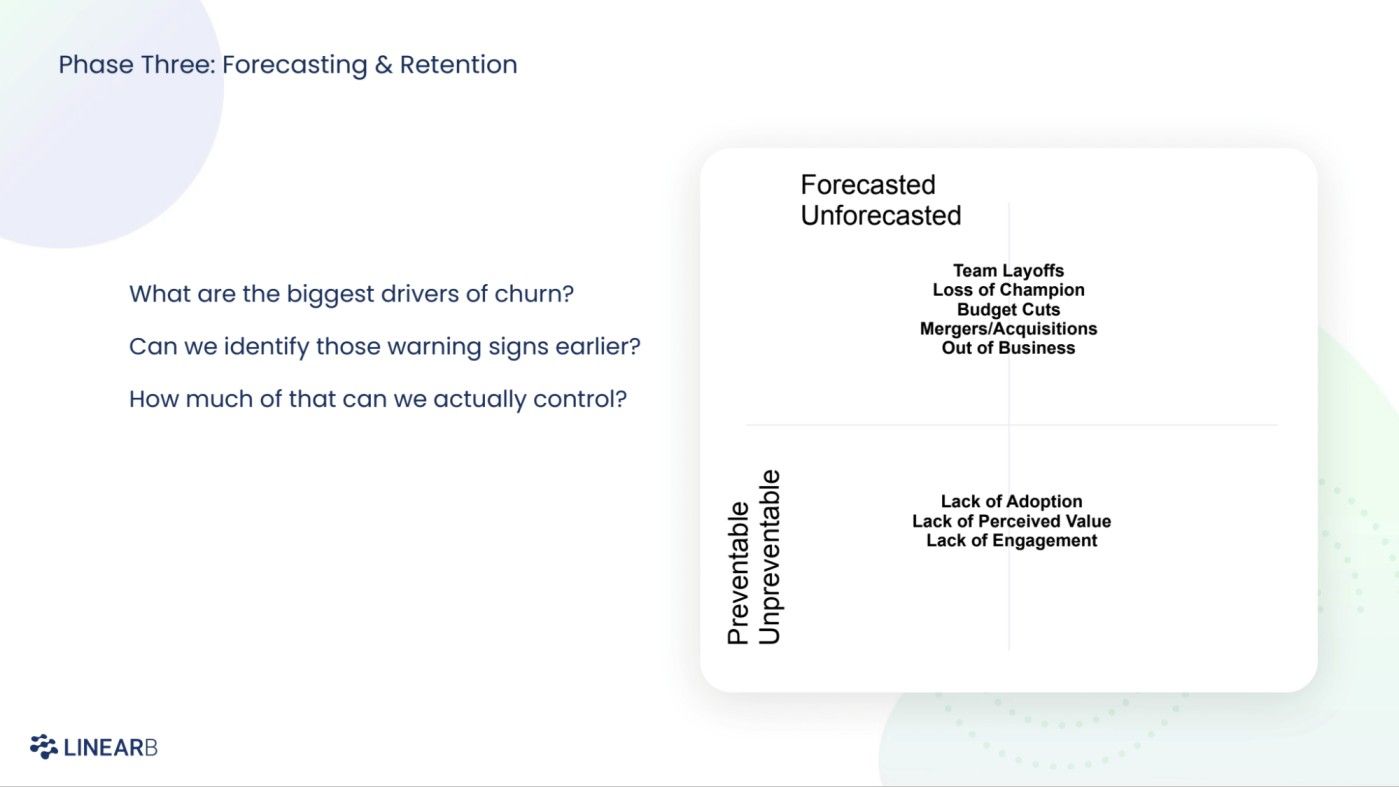
I consistently share this churn matrix with my board every quarter, providing a comprehensive overview of churn and its categorization. By clearly delineating what could have been prevented and what couldn't, we foster a deeper understanding of the challenges we face.
This matrix also serves as a guide to anticipate what the "new normal" will look like as we navigate the path to recovery.
While economic impacts have made customer success challenging, we are actively working on forecasting retention, identifying preventable and unpreventable churn drivers, and maintaining a proactive approach to minimize surprises.
By continuously adapting our strategies and leveraging available tools and insights, we strive to mitigate churn risks and ensure success in the ever-changing landscape of customer success.
Adapting playbooks for ongoing engagement and value emphasis
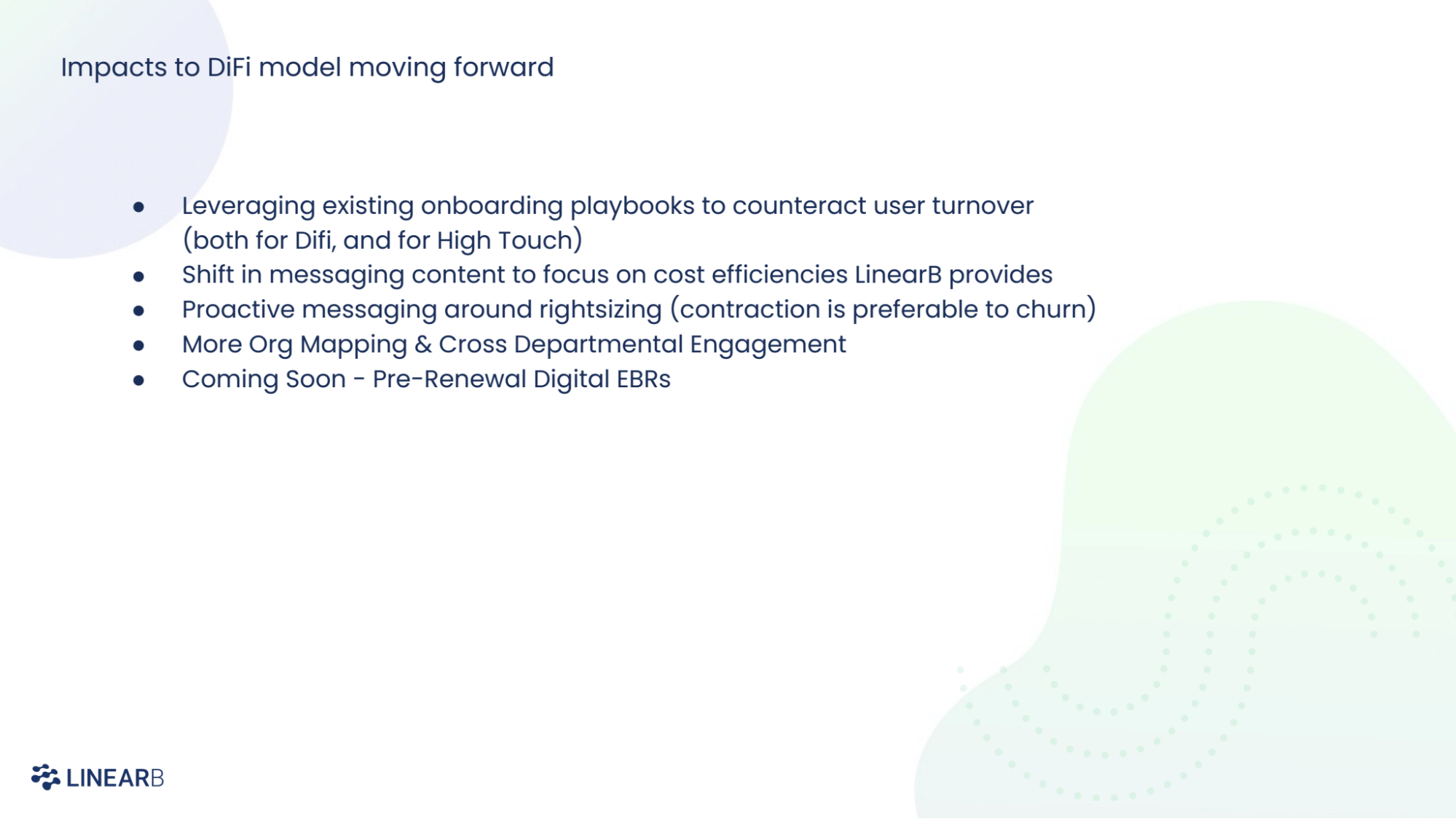
In light of the digital-first model's impact, we are making several adjustments to our existing playbooks and strategies. One key area we are focusing on is user turnover.
Instead of treating the onboarding journey as a one-time event, we now recognize the importance of ongoing engagement as new team members join and others leave. Whenever a new person joins the customer's team, they receive an onboarding journey to ensure they are set up and supported from the start. This approach applies to both digital-first and high-touch customers.
Our messaging has also shifted to highlight the cost efficiencies and developer productivity improvements our tool offers. We emphasize that our tool saves money by enabling organizations to achieve more with fewer resources.
To illustrate this, we measure the full-time equivalent (FTE) value of the dollars and time invested in our tool. This approach helps customers understand the impact on their budget and resource allocation.
In certain cases, we have even engaged in proactive messaging about right sizing. Although this approach may feel uncomfortable, it becomes necessary in the current economic climate.
We approach customers and propose renewing their licenses at the level of utilization they currently have, even if it's lower than their original subscription. By doing so, we address their concerns about underutilization and offer a solution that retains their commitment at a reduced level, rather than risking complete churn.
Furthermore, we are expanding our efforts in org mapping and cross-departmental engagement. We leverage tools for resource allocation and cost capitalization reporting, which are of particular interest to CFOs. By involving these stakeholders in our conversations, we demonstrate the value and impact of our tool beyond the customer success organization.
To streamline the renewal process, we are implementing pre-renewal digital Executive Business Reviews (EBRs). Instead of conducting lengthy EBR meetings, we compile all the relevant information into an automated deck and share it with the customer.
This allows them to review their usage summary for the year, highlighting both positive and negative aspects. We anticipate increased engagement through this approach, while still leaving room for further discussion if needed.
Final considerations for building and managing a digital-first program
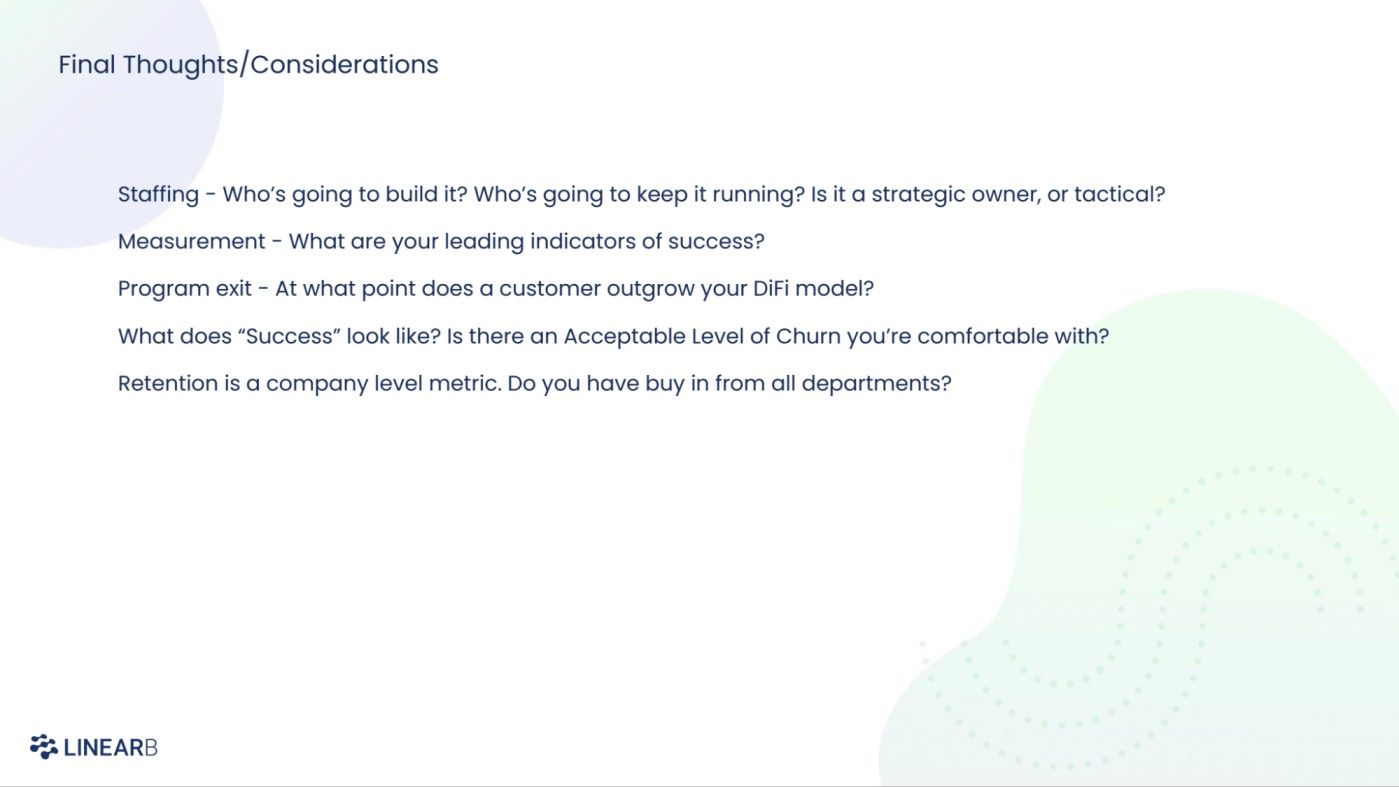
When implementing a digital-first program, it's crucial to consider who will be responsible for building and maintaining it. This role can either be a strategic owner or a tactical owner, depending on the resources and bandwidth available. In my case, I dedicated an entire headcount as a strategic owner, but you should assess your own situation and determine what is right for your organization.
To measure the success of the program, it's important to focus on leading indicators rather than relying solely on churn, which is a lagging indicator. Adoption metrics and customer engagement can provide valuable insights into the effectiveness of the program.
Another aspect to consider is the program exit strategy. What happens when a customer outgrows the digital-first program? Define the metrics or thresholds that determine when a customer should transition to a different level of service.
It could be based on factors like revenue, subscriber count, or other relevant criteria. Similarly, if a customer wants to downsize their engagement, how will you handle that transition and communicate the changes effectively?
Defining success is crucial. Consider the specific goals and outcomes you want to achieve. It may be to maintain retention levels while reducing the need for dedicated resources, or it could be to improve retention rates overall. Establish clear success metrics and report on them regularly to track progress.
Remember that customer retention is a company-wide responsibility. It's not solely the responsibility of the customer success team. Sales, marketing, and product teams all play a role in ensuring customer satisfaction and long-term retention.
Foster open communication and collaboration among different departments to create a cohesive approach to customer success.
By considering these factors, building a collaborative approach, and aligning goals across the organization, there's a greater chance of success in navigating the challenges and maximizing customer retention in a digital-first model.



 Follow us on LinkedIn
Follow us on LinkedIn




